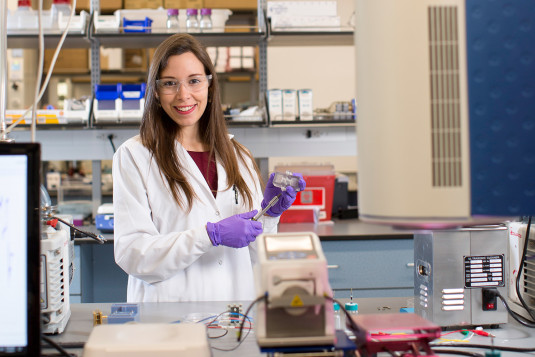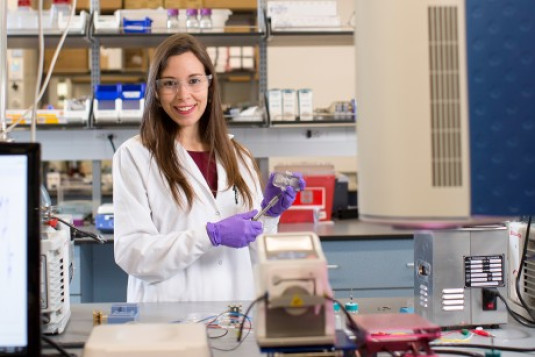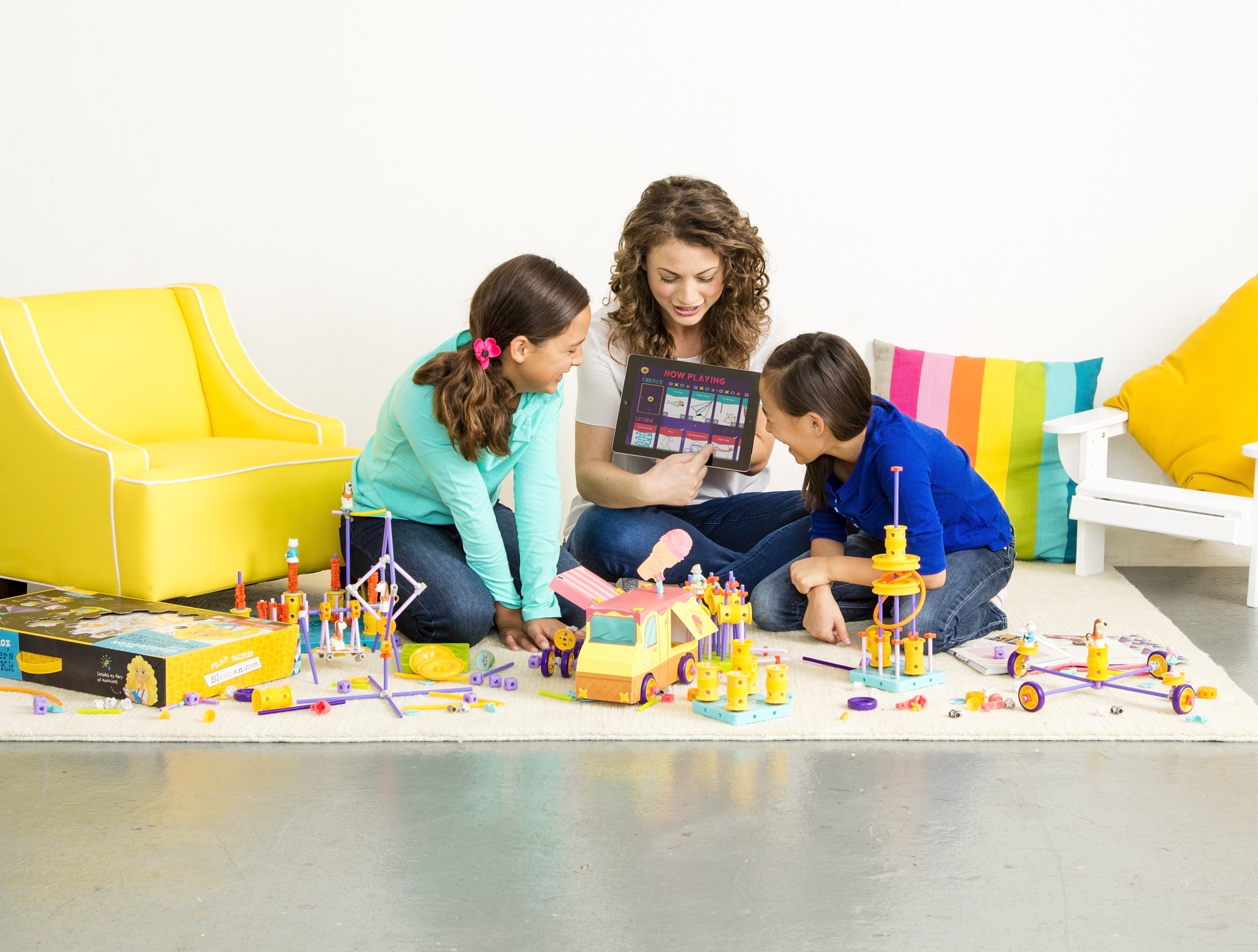
Building blocks of opportunity
Growing up, Debbie Sterling’s favorite subjects were math and art, but she didn’t realize her creativity and knack for numbers would set her up for a successful engineering career. In fact, she didn’t even know what engineering was until college. Now, she’s made it her mission to introduce young girls to engineering concepts in fun and engaging ways through GoldieBlox, her visionary line of toys and children’s media.
25 min read
Each month, our Journeys of Innovation series tells the stories of inventors or entrepreneurs who have made a positive difference in the world. Hear it in their own words or read the transcript below.
Debbie Sterling: Before I started GoldieBlox, there was this deep-rooted stereotype in the toy industry that building was a boy play pattern, and princess was a girl play pattern, and that the pink aisle is for girls, and the blue aisle is for boys.
When GoldieBlox launched, we just came out with a bullhorn, just saying, "No, this is wrong. And girls deserve more than just princesses, and girls can build, too." And that message went viral.
And very quickly, the dominoes just started to fall. And so, I think with the success of GoldieBlox, it was sort of a wake-up call to the toy industry that the times have changed, and that they needed to catch up with the expectations of parents today, which is like, I want my daughter to have every advantage that our sons have had.
Megan Miller: In college, Debbie Sterling was inspired by the possibilities and promise of engineering. But as a woman in a male-dominated field, she faced an uphill battle to be accepted and heard. Fueled by her experiences, she invented GoldieBlox, a line of toys designed to get young girls interested in science, technology, engineering, and math, or "STEM." In doing so, she challenged the stereotypes that keep women out of these fields and started a movement in the toy industry that's breaking down barriers for the next generation of women.
I'm Megan Miller from the United States Patent and Trademark Office. I recently spoke to Sterling about her experiences as a female engineer, how she built an award-winning toy, and her mission to forge new paths for women in STEM.
Girls deserve more than just princesses, and girls can build too.
Debbie Sterling: My journey into engineering began when I was a freshman at Stanford and I was trying to figure out what I wanted to major in. And I stumbled into a mechanical engineering 101 class, something I probably never, ever in a million years would have considered had it not been for a high school math teacher who encouraged me to try engineering.
And when I went to that class, it was actually the first time in my life that I learned what engineering even was. And I was so excited because I learned that engineering is solving problems and inventing new ways to do things, to help people, and help make the world a better place. And I decided right then and there that it was what I wanted to do with my life.
But when I made the decision to major in engineering in college, what I didn't realize initially was it was going to be a very male-dominated major, and that in many classes, I was going to be one of very few women.
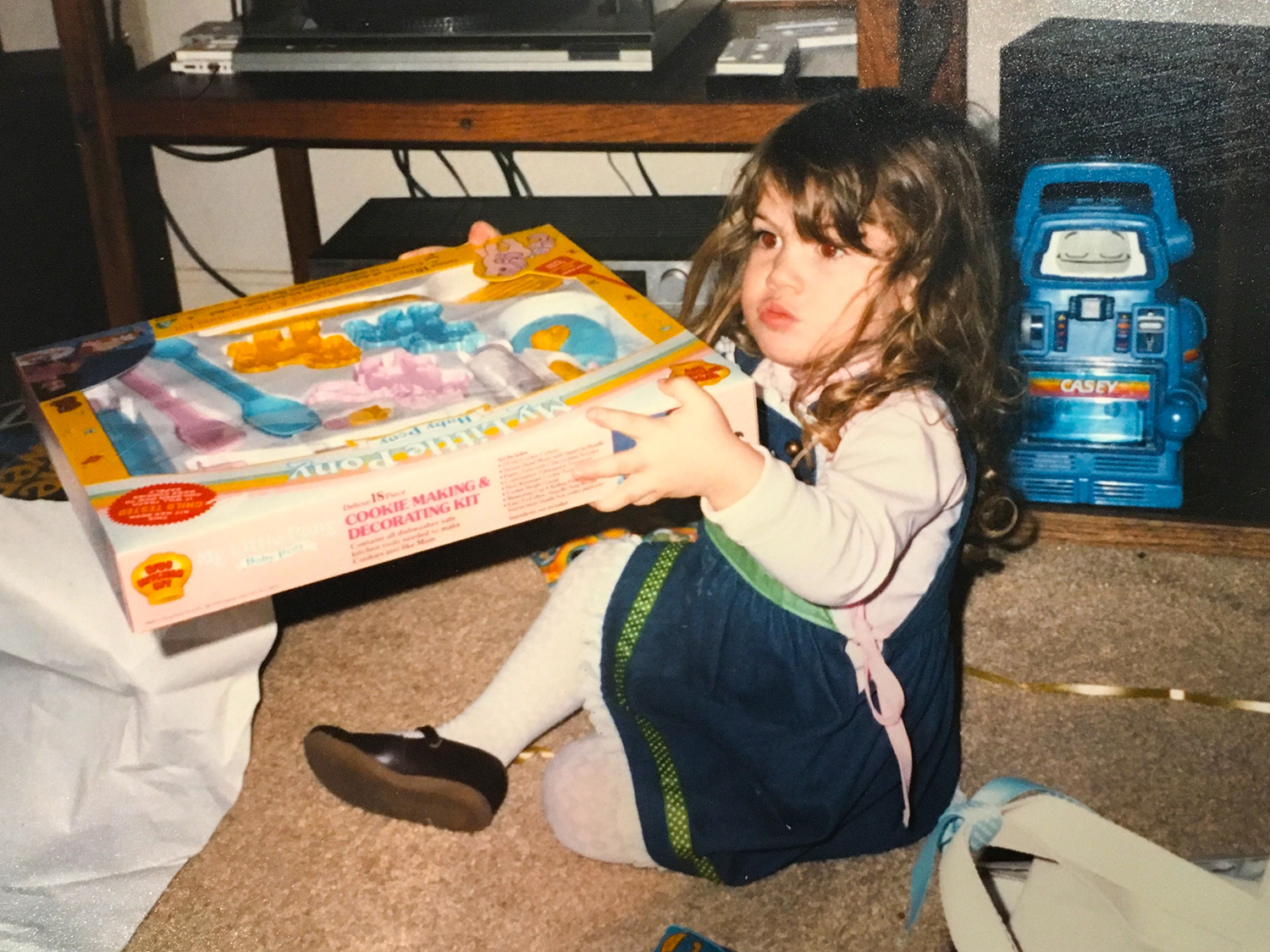
As a kid, Sterling spent much of her time playing with stereotypical "girls'" toys. By the time she got to college to study engineering, she felt others were better prepared and already knew the material, while she was learning it for the first time.
I faced a ton of adversity as an aspiring female engineer. I remember being in mostly male classes and working in group projects where a lot of the guys in my group would just sort of steam roll right over me. And I felt like I couldn't really contribute any ideas to the project, or they didn't like my ideas, or did not think I was smart enough or good enough to be there and be contributing.
I remember oftentimes just feeling like I didn't belong. And there was one episode in particular that was probably one of the most humiliating things that ever happened to me in my life—a couple of TAs in an engineering class that I had humiliated me in front of the entire room on a project that I'd actually spent a lot of time on and worked really hard on, but wasn't quite getting the material. And that was the moment that I really almost gave up and dropped the major entirely.
I had to keep reminding myself why I had chosen it and had to really kind of form the grit that was needed to stick with it when it seemed like so many people were questioning why I was doing it.
Megan Miller: What gave you the idea to start GoldieBlox?
Debbie Sterling: The idea to start GoldieBlox happened at this event that I attended with my friends called "Idea Brunch," where we'd all get together once a month, cook a big breakfast, and then each person would get up in front of the room and pitch an idea for a few minutes, and then we'd all chat about it and move on to the next one.
And in this Idea Brunch, my friend Christy got up. She was complaining about how few women there were in our classes. And she attributed her interest in engineering to playing with her older brother's construction toys from a young age, and that those taught her how to build and tinker, and she always wanted to do engineering because of those toys. And she made the argument that girls aren't really encouraged to play with those toys. And if more girls were encouraged to play with construction toys, maybe more girls would want to go into engineering.
And so, it just hit me in that moment as I was sitting there listening to her that it felt like almost this life calling kind of moment, where it was like my whole life flashed right before my eyes, and it seemed to me clear as day that this was the best idea I'd ever heard. And not only that, but it was something that I had a unique experience and background to be able to tackle an idea like this and to build something.
Ever since that day, it's been the idea that's kind of gotten me up every morning and gotten me so excited to try and tackle this big idea.
Megan Miller: What was your first step to get your idea off the ground?
Debbie Sterling: So the first step to get the idea off the ground was to really just start researching, because I did not have any background in the toy industry. So I spent countless hours going to toy stores, observing what was popular. I spent a ton of time just playing with kids, observing how they play, how girls and boys play differently. I read every research article that I could on boys and girls, articles by neuroscientists who study this sort of thing and who understand gender differences in the brain. And after months and months of researching, it led me to some really big "aha" ideas, that I think if I had just right away tried to jump to the solution, I never would've done it in the way that I did.
I think the biggest "aha" that I had from all of this research was that construction toys really do help develop motor and spatial skills. And so kids early on in playing with construction toys have an advantage in engineering. But girls and boys play with construction toys very differently in that girls really love character-driven, storytelling type of play. More so than boys, who tend to be interested in just building for the sake of building, if you will. Girls tend to want to build things for their purpose, or follow along a story. And so that was my big insight that led me to my first prototype then of GoldieBlox, where the idea was to blend storytelling with building as a way to get girls more interested in building with construction toys.

Before going into production with her first toy kit, "Goldie Blox and the Spinning Machine," Sterling tested her prototypes with hundreds of kids. Testing helped her refine the kit, making it more engaging for kids while teaching basic engineering concepts.
Megan Miller: Can you tell me about those first prototypes and how you tested them?
Debbie Sterling: My very first prototypes were very rough, but the general idea was I wrote and illustrated a storybook about Goldie, the girl engineer, who builds machines to solve problems and help her friends.
And so my very first book that I wrote was called "Goldie Blox and the Spinning Machine," where Goldie builds a belt drive to help her dog, Nacho, chase his tail by spinning him around on the top of a wheel. And so in the story, Goldie is using a wheel and axle threaded with a ribbon to create a belt drive. And then these pieces are all available so that kids, as they read along, they can build the same belt drive that Goldie is building, and with little character figurines kind of spin the dog around.
And so I wrote and illustrated the story, and then I just used stuff from around the house and from the local hardware store and craft store to start prototyping these construction toy pieces. I wanted to kind of teach the basic simple machines of wheel, wheel and axle, and belt drive, and those sorts of concepts, using common household objects. Just very rough, rapid prototyping, to just get the idea that was in my head into a form where somebody could look and see and feel it and test it out.
And then for several months, I just went around and tested these prototypes with kids. And I would show up at people's houses and bring a video camera and put the prototype out and just sit and observe and watch them play, and see if they were having fun, if they were getting stuck, if they were having trouble. And each time I went and observed a test, I learned so much. And then I'd go back and tweak the prototype and fix this here and fix that there and then go take it out again.
And so finally, after doing these tests with over a hundred kids, I finally felt like I had something that was really successful, that kids were having fun with, that they could understand, and that they were learning from.
Megan Miller: With prototyping and testing complete, Sterling went to the toy industry, confident she'd be able to drum up interest. But once again, stereotypes stood in her way. Toy industry insiders told her that while her cause was noble, her product would never sell. They said heavyweights in the industry had tried and failed to develop construction toys for girls. Girls just didn't want to build—they wanted to be princesses. So pitch after pitch, Sterling came up empty-handed, but she didn't let that stop her. During our conversation, I asked her how she bounced back after repeated rejection.
I knew deep down that it was a good idea, that it was something that was long overdue, and it was something that girls around the world really needed.
Debbie Sterling: I will say that was a pretty low blow, and something that I wasn't expecting, because at this point, I had already tested my prototype with hundreds of kids, and I knew I had something really special. And I just realized that a lot of these people in the toy industry just had old thinking, and they were kind of mired in the past, and they just didn't get it. I think I knew deep down that it was a good idea, that it was something that was long overdue, and it was something that girls around the world really needed.
I think that all of that initial rejection actually is what fueled me to take my idea and put it up on Kickstarter and do a crowdfunding campaign. And that Kickstarter campaign just went viral, practically overnight. And by the end of the campaign, I had almost every major toy store writing in to me begging for the product.
So it ended up in some ways being really great that I had that initial rejection, 'cause it really pushed me to try something that I wasn't going to try. And doing that Kickstarter really was what kick-started GoldieBlox and kind of transitioned everything from just sort of like an idea that I had in my living room to a viable company.
Megan Miller: How has the company grown since then?
Debbie Sterling: In the early days of the company, we were just scrambling to figure out how to produce our toys and ship them out to our Kickstarter backers. We were literally packing boxes ourselves with packing tape and getting all of our friends to come and help.
And over the years now, as the company has grown and we've expanded into different types of products, whether it's construction toys, science kits, arts and crafts kits, and we've really expanded into multimedia. So the company has developed hundreds of shows that put these kinds of role models that we want kids to see front and center—where they can see girls and people from diverse backgrounds doing engineering, doing coding on camera—to get them excited about it and to show them how fun it is and that this is for everyone.
And we keep building and growing this brand of content and entertainment and products, all with the same goal we had from day one, which is to really just make STEM accessible and fun for all kids, and especially girls. Because this gender gap in STEM still persists. And less than 25% of professionals in STEM fields are women, yet the fastest growing jobs are in STEM. And we need this next generation to get excited about STEM, and so we've got to keep finding ways to make it fun and exciting for them.
Megan Miller: GoldieBlox continues to find new ways to get young girls excited about STEM. But piquing their interest and keeping them engaged is about more than just great toys. Another critical component is great branding. For GoldieBlox to entice girls, Sterling knew she needed to create a character they would love. When we spoke, she told me a bit about her inspiration for Goldie.
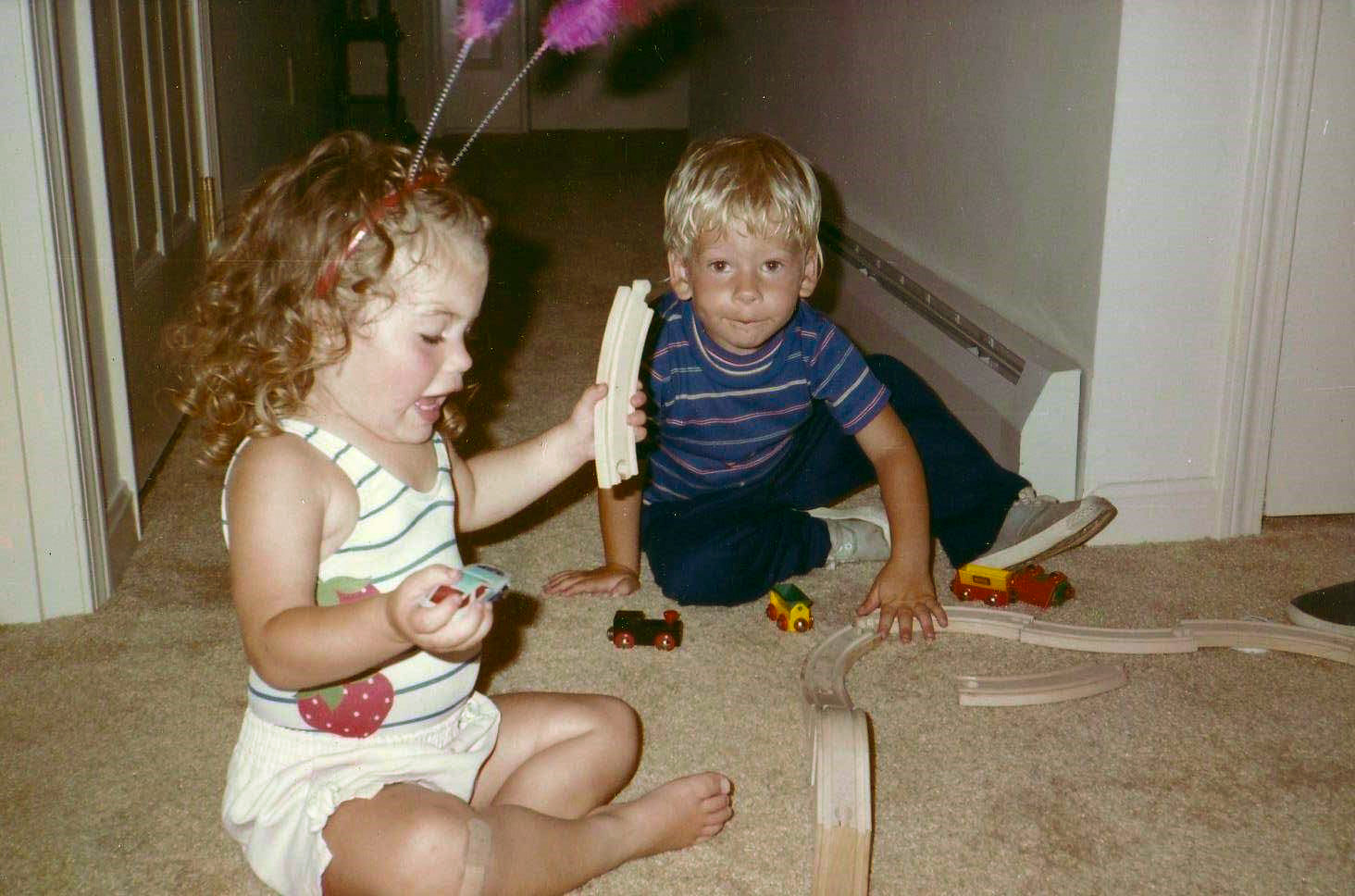
Reflecting on her childhood, Sterling says, "I think I was a STEM kid, but I didn't realize I was a STEM kid." Though she loved doing hands-on projects and building things as a child, she wasn't introduced to engineering as a career choice until much later.
DEBBIE STERLING: Goldie is really like the role model that I wish I had growing up. And what inspired me for this character was, I wanted a female role model for girls who's an engineer, an inventor, but who isn't perfect. Somebody who makes mistakes all the time but laughs and learns from them.
What I really wanted to create in this character was to kind of defy all the stereotypes that I had grown up with on what an inventor looks like or acts like, because I think a lot of kids grow up with this archetype of the boy genius inventor. And you see that in a lot of kids' media—whether it's Jimmy Neutron, and Sid the Science Kid, and Handy Manny, and Bob the Builder, and Bill Nye the Science Guy—again and again and again, there's just this archetype of this boy genius.
And that's what I really wanted to disrupt with Goldie. I wanted to create a girl inventor who's actually not some kind of prodigy genius in that sense, but more of a creative genius who thinks outside the box and who's kindhearted, who has a lot of friends, and who girls and boys can really relate to. Somebody they want to be friends with. Somebody who's a little bit mischievous, always diving into things headfirst. And somebody who looks at life not as it is but how it could be, and is always trying to invent a better world.
MEGAN MILLER: How did you come up with the name for GoldieBlox? Can you tell me about that moment?
DEBBIE STERLING: I was noticing at the toy store and all of my research that a lot of the most popular toys for girls were Disney princesses. And Disney has a long history of going back and taking old fairy tales and kind of re-imagining them and turning them into big characters.
And so I started to kind of brainstorm old fairy tales to see if there was something that I could do similarly. And that's when I stumbled upon Goldilocks. And I thought that Goldilocks was kind of an interesting story about a little girl that hadn't, nothing had really been done with her yet.
And then in the shower of all places, I came up with the thought of GoldieBlox, kind of a little pun and play on the name. And I loved that idea of GoldieBlox, because it kind of sounded a little bit like Goldilocks, but it was a girl, and it was building blocks, and it just struck me as the perfect name. And I ran out of the shower with my hair still soaking wet to see if that name was available, and it was. So I got the website and immediately started looking into trademarking that name.
Megan Miller: You've invested so much into your company and your brand. So it makes sense that you'd want to protect your intellectual property. And you have patents, trademarks, and copyrights. So what made you realize you needed each one of those?
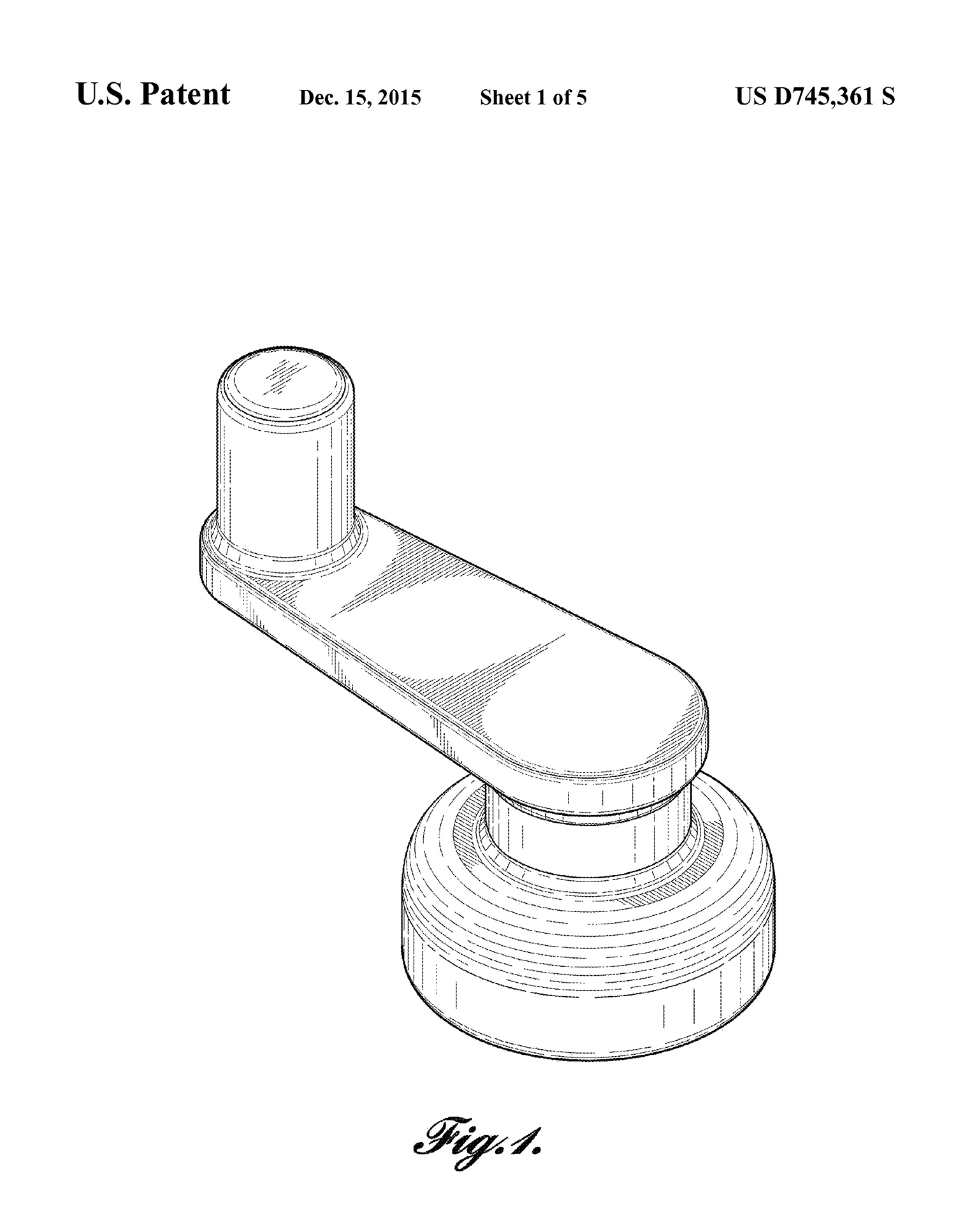
On December 15, 2015, GoldieBlox received U.S. Design Patent No. 745,361 for the crank used in "GoldieBlox and the Spinning Machine," as well as other toys. The above drawing is figure 1 in the patent.
DEBBIE STERLING: With the patents themselves, I started to realize that a lot of the construction toy pieces that I was designing were unique. And some of them weren't, some of them were kind of generic. So the axles that I was creating that were inspired by wooden dowels, those were not unique.
So then there were some other pieces that I was creating that were very unique. Our wheels, for example, that we created for the kit. Initially, they were inspired by thread spools, but we started to make them more and more interesting and complex to kind of just fit with our axles in different ways. And there were some really novel ideas in there, and started to realize, "Oh, wow, this is something pretty unique that nobody has ever come up with before. And before we take this to market, and especially before we go into the manufacturing process where we start producing a lot of these, it's important to get a patent on this stuff because we invented it first. And if we don't do that, somebody could copy it."
The same was true with the copyrighting of all of the books that I was writing and illustrating. And also other things that were unique to us, like the name of the company GoldieBlox, and some of our other taglines and other things that we were coming up with for the company.
MEGAN MILLER: GoldieBlox has a really important social mission. So for you, sharing your ideas is really important to spread your message, especially when you were starting out and you needed support. So how do you find the balance between sharing your ideas so they can gain traction and protecting your intellectual property?
Debbie Sterling: In my early days, it's funny because I think I was, a lot of people had warned me, "Oh, don't share your ideas because, you know, the toy industry is notorious for copying ideas. So you can't, you know, don't show anybody your ideas. And if you do show anybody, you need to make everybody sign an NDA, a nondisclosure agreement."
And so I took this advice to heart, and I remember getting a ton of these nondisclosure agreements that I got from my lawyer, and I would not show my idea to anybody unless they signed one. I even made my mom sign one. And I just had stacks and stacks of these NDAs. And looking back, that was just entirely not necessary.
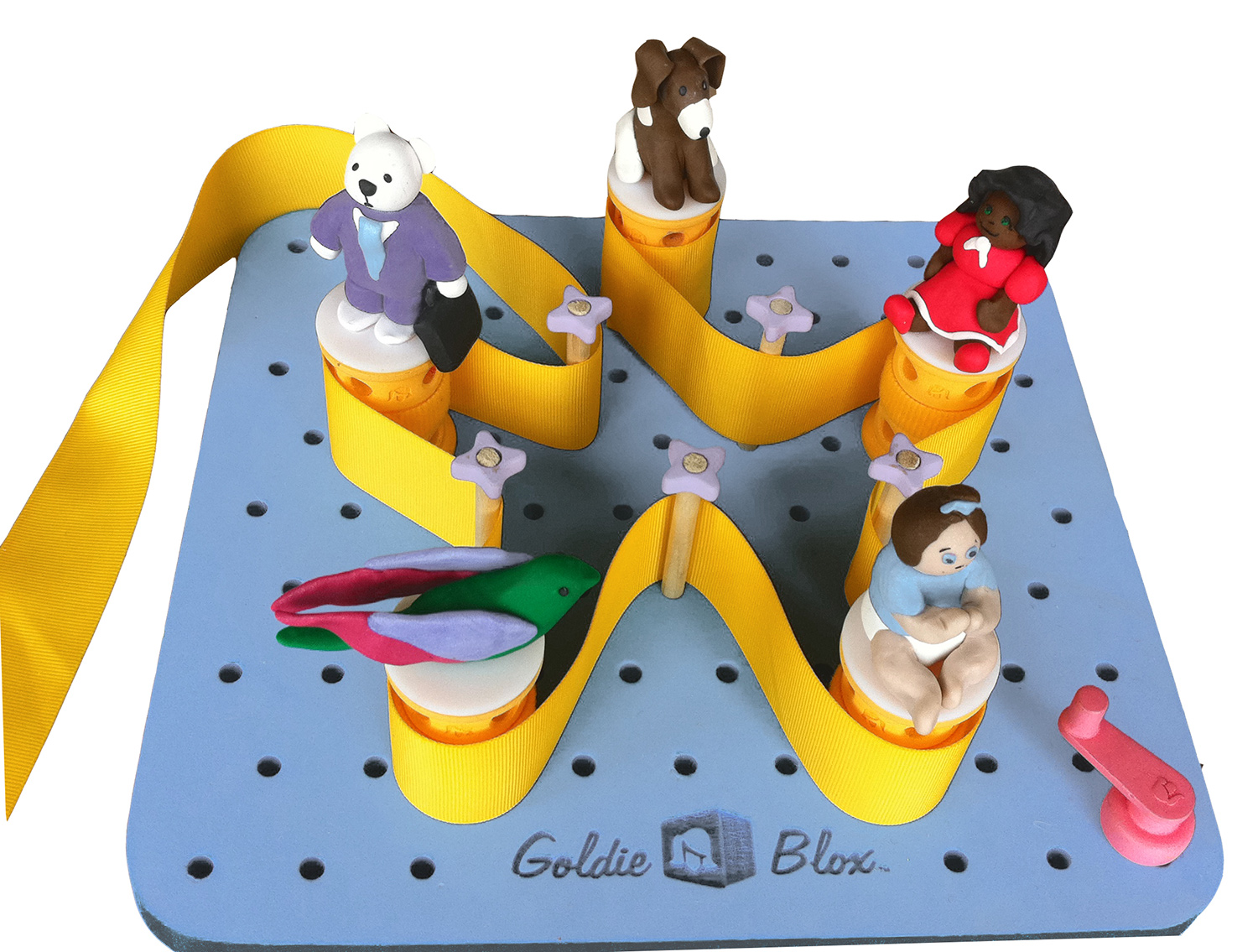
Sterling's first toy kit included an illustrated storybook about her character, Goldie, building a belt drive to help her dog chase its tail. While reading the story, girls used the included pieces to build their own belt drive, like this one, along with Goldie.
Because the thing is, great ideas are a dime a dozen, and really the hard part is in the execution, and really putting in years and years of time and effort and energy and resources to take an idea in your head and actually make it happen. And in order to do that, you also just need a lot of great input from people. So you can't be afraid to show it to get feedback from people, or you're just kind of talking to yourself and not making it any better.
It just kind of depends on who you're getting feedback from. Obviously, if you're meeting with a direct competitor and showing an idea that they could easily go and do themselves, you might want to be careful about that. But if you're showing your ideas to like, in my case meeting with a teacher, like an elementary school teacher, to get their input, they probably don't need to sign an NDA. You're probably fine. So I think it's just kind of being thoughtful about who you're showing your ideas to.
Megan Miller: What role does intellectual property protection play now for GoldieBlox?
Debbie Sterling: Well, intellectual property continues to play a huge role for GoldieBlox. The brand GoldieBlox, and this name that I remember coming up with in the shower 10 years ago, has now built a huge fandom around it, with over 27 million fans just in the U.S. alone who love the brand and what it stands for. And so it's an incredible asset that the company owns to have something that has so much meaning in so many people's lives and a brand that people really love.
And as more and more people fall in love with our characters and our stories and our toys, those concepts and ideas, their value increases in the marketplace. And to have protection on that—it's just imperative as a business.
Megan Miller: What's on the horizon for GoldieBlox?
Debbie Sterling: GoldieBlox is continuing to develop more great entertainment that highlights and celebrates female STEM role models that kids can look up to, to disrupt that stereotype that science and engineering is a boys only club. And so we're developing all kinds of shows and characters that really just send a message to kids from a young age that STEM's fun, and it's for everybody, and that they can do it, too.
And our goal is for kids of all diverse backgrounds to be able to go to GoldieBlox and be able to see characters that they identify with and relate to doing STEM in a way that makes it fun and exciting for them. And then to be able to watch that content and get inspired, and then want to go make stuff with their hands, to want to go build and create or code something.
But all of it, at the heart of it, again, it's all about showing how fun STEM is and showing them it's for everyone.
And so we're developing all kinds of shows and characters that really just send a message to kids from a young age that STEM's fun, and it's for everybody, and that they can do it, too.
Megan Miller: How do you think the toy industry has changed since you started GoldieBlox?
Debbie Sterling: The toy industry has changed a lot since I launched GoldieBlox. And I do think that GoldieBlox has played a role in that change, which is something I'm really proud of. Before I started GoldieBlox, there was this deep-rooted stereotype in the toy industry that building was a boy play pattern, and princess was a girl play pattern, and that the pink aisle is for girls, and the blue aisle is for boys.
When GoldieBlox launched, we just came out with a bullhorn, just saying, "No, this is wrong. And girls deserve more than just princesses, and girls can build too." And that message went viral.
And very quickly, the dominoes just started to fall. And Target took down its gender labeling in its toy aisle. And Mattel started to have Barbie be a computer scientist and Barbie to do STEM. The makers of Bratz dolls, which were some of the most controversial dolls for girls, made their STEM line of dolls.
And so I think with the success of GoldieBlox, it was sort of a wake-up call to the toy industry that the times have changed, and that they needed to catch up with the expectations of parents today, which is like, I want my daughter to have every advantage that our sons have had. And so now I think there's been a lot of change, which is good, but there's still a long way to go.
There's still a lot of the same stereotypes that have been successful in the past and that have made a lot of these toy media companies a lot of money. And so they're continuing to wash, rinse, and repeat some of the same formulas that can have damaging effects on kids. And that's still the majority of the media and toys that are popular that kids consume. And so GoldieBlox is more the exception than the norm today.
But I think things are slowly starting to shift and move into the right direction because parents demand it and because kids are smart. And kids are naturally curious and excited, and want to learn new things and don't want to be put in a box. And so I think things are definitely moving in the right direction, but there's still a ways to go.
Megan Miller: Thinking beyond the toy industry, what's your vision for future generations of woman engineers? Where do you think we should be aiming?
Debbie Sterling: It used to be that most of the doctors were male, and there were hardly any female doctors, and they were the minority. But then over time, it became more normal and accepted in our culture when we were given more opportunities, and lo and behold, today now you'll see kind of an even split of male and female doctors. Right?
I think the same thing will happen with engineering. You don't refer to doctors as a female doctor, a male doctor. It's just a doctor. And I think the same will be true with engineers. And this is weird to say, like female engineer versus male engineer. And I’d love to be in a place where engineering is a really great and exciting job that I could maybe have when I grow up, and there's no stereotype from an early age that that would be a job that would be done by a male or a female.
And when that happens and you have more women in engineering, they're not in a male-dominated field. It's just a diverse field with lots of different people and different perspectives, all working together to solve problems. So they're not dealing with all of the things that I had to struggle with and that a lot of generations before me had to struggle with.
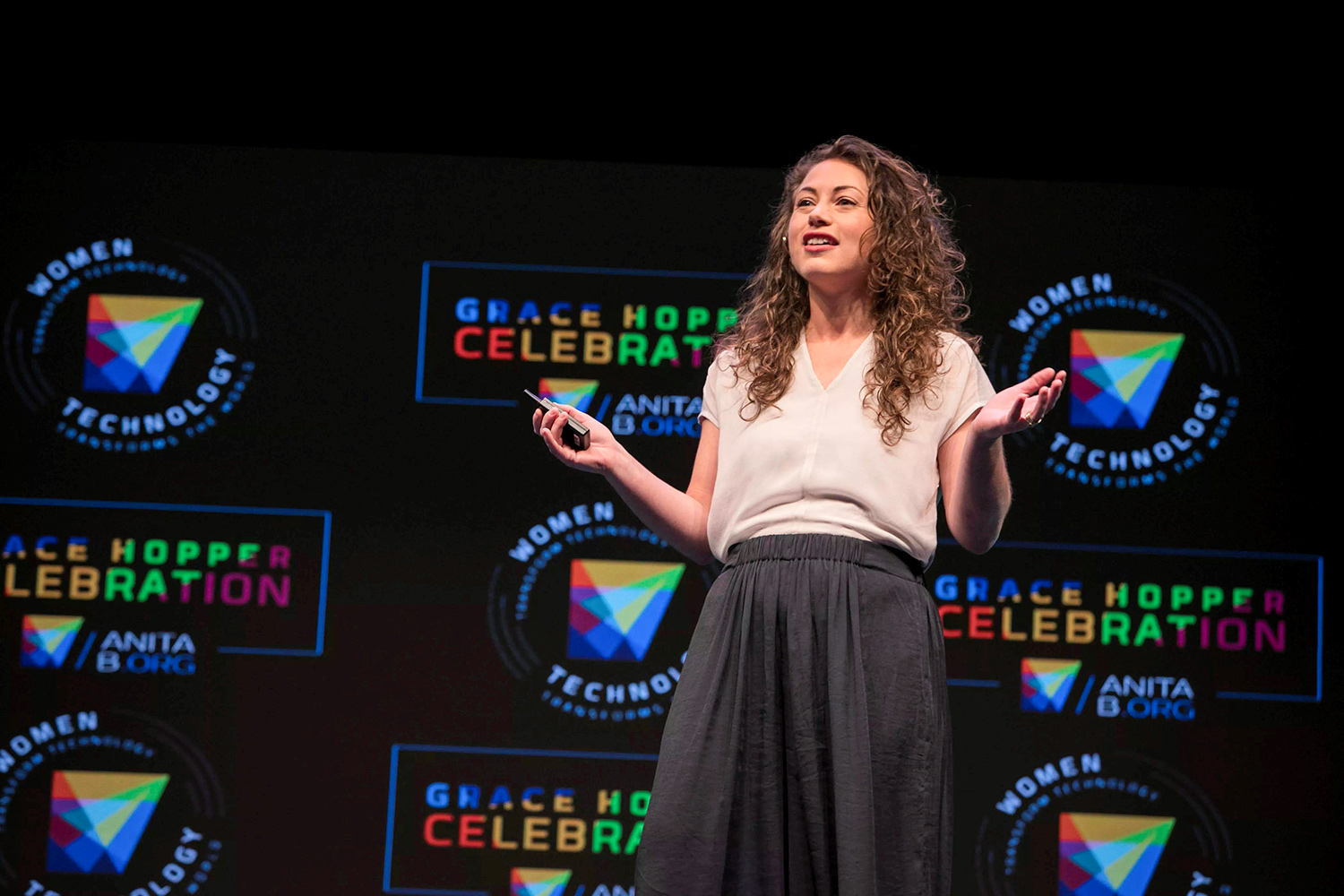
Sterling delivers the keynote address at the Grace Hopper Celebration of Women in Computing in October 2017. Among the attendees were many young women who were inspired by GoldieBlox toys and were pursuing STEM careers as a result.
Megan Miller: Looking back at what you've accomplished, what are you most proud of?
Debbie Sterling: One of my proudest moments—a few years ago, I was invited to be a keynote speaker at the Grace Hopper conference, which is an annual women in tech conference. They have a lot of young women there who are interested in tech.
And afterward when I was finished, there was a line just practically out the door of young women who wanted to meet me. And one by one, they came up and told me that they had played with GoldieBlox toys when they were younger or watched our videos or played with our apps, and that those experiences were kind of the spark that got them interested in engineering. And now here they are, about to major in engineering in college. It was just so fulfilling to hear that, and to think that GoldieBlox could've had an impact on so many young girls' lives was just music to my ears, and it's why I started it in the first place.
Megan Miller: What advice do you have for women and girls who want to be innovative in science and engineering?
Debbie Sterling: Well, my advice is to stick with it and don't let other people tell you that you don't belong because you actually, you do. We desperately need more girls and women in STEM.
And I was almost pushed out a million times. And I remember when people would laugh at my ideas, and it made me second-guess myself, or think that I wasn't good enough because my ideas were different. And many years later, after winning the toy of the year award, and I was still questioning myself. And finally, I realized my ideas were different, and that's why they were so good, because they were different and unique, and I had this different perspective.
And that's what we need to invent better things and make things better in the world for all people. I try to kind of tell kids, and especially young girls, to not let people dissuade them. Or if somebody laughs at your idea and doesn't think it's good, that doesn't mean it's not a good idea. And to believe in yourself.
My ideas were ... different and unique, and I had this different perspective. And that's what we need to invent better things and make things better in the world for all people.
If you're trying to figure out a problem, you don't just immediately jump to a solution. You take a very multi-disciplinary approach, and you research the problem from every different angle and talk to different people and try to figure out a new way to solve it that maybe hasn't even ever been done before. And that's innovating.
The way that I learned engineering was, each problem you just break down into small, manageable steps. And along the way, you really try to think outside the box and come up with new ways to do things. And so as you start to learn these skills on how to build new solutions, and you're not rigid in your thinking but you stay really open-minded, and you work together with others and you collaborate with diverse perspectives, and if you think outside the box, you can really change the world. And that's what engineers do. They change the world, and they make the world a better place every day.
Megan Miller: Sterling's journey of innovation shows just that. Because she isn't afraid to think differently, she's made a meaningful and lasting impact. Beyond inspiring countless young girls through GoldieBlox, she's proven that girls really do want and deserve more than the traditional offerings of the "pink aisle," sparking a major shift in the toy industry. For future generations of women and girls, Sterling hopes this will open new doors in STEM, but more importantly, that increased diversity in those fields will, as Sterling says, make the world a better place.
From the USPTO, thanks for listening.
Credits
Produced by the USPTO Office of the Chief Communications Officer. For feedback or questions, please contact inventorstories@uspto.gov.
Interview and story production by Megan Miller. Audio editing and contributions by Jay Premack. Additional contributions from Marie Ladino, Lauren Emanuel, and Linda Hosler. All photos courtesy of GoldieBlox.


